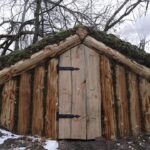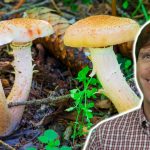How to Forage Free Food in Your Own Backyard!
Hey everybody! Rob Greenfield here and today I am going to teach you how to forage in your own backyard. Or if you don’t have a backyard, your neighbour’s backyard. If they don’t have a backyard, somebody’s backyard. I’m going to introduce you to plants that are growing freely and abundantly all around us. A lot of us think that our food has to come from the grocery store and that we have to buy it. But the truth is, there are thousands of species of foods that are both nutritious and delicious and medicinal and free! Growing right in our yards, often that we think of as weeds. I’m going to start first with the dandelion, one of my favourites. Right over here. And a lot of people are probably familiar with this plant. This is the dandelion. This is the flower, right here. And then these are the leaves, right here. And the flower turns into a seed head afterwards and these are the seed heads that have already gone but right here are the seeds, still. (Blows the seeds.) And it’s a beautiful thing just to blow those off. So, dandelion is a very bitter (munches on the plant) plant. It’s very nutritious and it’s a medicinal one. I want to say that this yard that I am in is basically a random yard. I’m in southern France, I’ve never foraged in France before, up until a few weeks ago. And this is just a yard of the host family that I am staying with. So I don’t know all the plants here. This is new foraging to me, but I’m going to introduce you to about 10 plants that there is a good chance you will be able to find in your yards as well. So that’s dandelions. Now I don’t have to go very far and what I have, right here, coming up, this looks like sorrel to me. Plants around the world can come in many different shapes and sizes and colours. For example, this looks like sorrel but check this out, right here. This plant also looks like sorrel to me. Oh wow, check that out, there’s this yellow spider. That probably came off the dandelion flower because it’s camouflaged right in with that colour. Back to the plants. This is sorrel and sorrel has a nice sour flavour and there is another type of sorrel that I’m going to show you in a bit. Let’s walk a little bit more and see what we come across. Okay. This is…right here, one of my absolute favourite plants. It’s very small right now. In a month or 2 this plant could be, possibly, 4 feet tall. But right now it’s a small plant and this is called lamb’s quarter. Lamb’s quarter is a relative to quinoa and the leaves of lamb’s quarter are often described to have sort of a nutty flavour. (Takes a bite) I don’t know if it’s nutty but it’s got a different flavour and I like it. Amazing thing is, you would look at all of these green plants and you would think they all taste the same but they definitely don’t. Lamb’s quarter is a relative of quinoa and you can also eat the seeds, as well, as a nice grain. This is one of my absolute favourites and it grows into big shrubby-like greens that produce incredible amounts of food. You’ll see where I am, I’m right next to this family’s garden. And what you’ll see is there’s almost nothing growing in this garden right now. But there is food growing all over in the yard. Tons of people have gardens and they’re pulling up the weeds, thinking that they’re a problem, but it turns out that a lot of these weeds are more nutritious than what they’re trying to grow in the garden. This is a perfect example. It’s spring, it’s early April, the garden doesn’t have food yet, but there’s food growing all over in the yard. Let’s walk down here a little bit. (Sound of crunching leaves under foot) Now, this is a beautiful plant right here. Most everyone is probably familiar with mint. There are different types of mints and how you can identify something that is in the mint family is it has a square stem. I’m going to pick a piece and when I spin it in my fingers you’ll see it’s not rolling as a round tube, it’s actually a square stem. So there are lots of different mints out there. I don’t know exactly what kind of mint this is but when it smells really nice and minty you’ve got yourself a good mint for making tea, for putting in your lemonade, for just munching for a natural breath mint. And mint is very easy to plant. You can take a piece of the stem…a woody piece, poke it into the ground and you can propagate mint and spread it all over that way. So this is a really nice mint that’s growing. I see more of it over here. I’m not sure what this plant is. I’m very curious about it. Something that I’d like to learn. Actually, this plant right here…I was in the Netherlands about 3 weeks ago and someone told me that this plant is called cleavers and they told me that before it gets to the point of being … it sticks to you…they said before it gets to that point it is edible. And I don’t know how to use it but, again, I’m in a yard that I have never foraged before arriving here 2 weeks ago. I’m in a climate…in a region…I’m in south France, I’ve never foraged here. So, I’ve done a lot of foraging. I foraged over 200 species of plants in my year of growing and foraging all of my food, but right now, this yard and this environment that I am showing you, this is new to me. This plant, right here, looks a lot like a plant that I forage when I am in Florida. And that would be…oh, now I am blanking on the name, but I don’t think it’s it. It’s just something that looks a lot like it and (pause) I want to say bacopa but I’m not sure so we’ll pass on that. Okay, let’s see. (Rustling sounds) Okay! Here we have a little more mint. Beautiful mint. Right next to it we have yarrow. Now yarrow is not so much of an edible. It’s a medicinal. Yarrow has been used as a styptic to stop bleeding. So if people got a big cut you could actually pack the wound with this stuff and I’ve also heard of it being used for horses as well in the field. So this is a really wonderful plant to know and I see it around the world. So that’s called yarrow. (Rustling sounds) Let’s see. Right here we have…oh, more of the cleaver… So this is the leaves of the raspberry bush. (Rustling sounds) And it is thorny. It is sticking to me. And raspberries are great. Blackberries are great. Most people know about those but a lot of people don’t know that the leaves are really good to make a tea out of. So you can make tea out of raspberry leaves. And this woods line is covered in actual raspberry bushes. So this is just a little bit of the new growth from the spring. So raspberry leaves. Another dandelion head and… (Blows the seeds) you can also just have fun with the plants, too. Nature provides not just food, not just medicine, but also entertainment, enjoyment and love. Okay I want to show you one of my absolute favourites and that is right here. (Rustling sounds) This is stinging nettle and the easiest way to identify stinging nettle is it stings. I am going to put my arm in here. Oh ya, that is stinging me good! There are these tiny little fibrous hairs on here and they break off and it stings you. So there are plants that kind of look like this but if it stings you, it’s stinging nettle or wood nettle. You can wear gloves or the sting actually is beneficial for you because it’s used to help with diabetes to circulate blood flow so I like to rub it on me. Now you wouldn’t eat this raw because you can imagine the stings in the mouth could be very painful, but you can make nettle tea and you can also just boil the greens and then eat the greens. And, ya, I’m really feeling that. So, this is a beautiful plant to use and, again, a lot of people would cut this down to get it out of their yards because they think it’s a problem but it’s actually super nutritious. I’m going to walk over here where there are some onions that I am going to show you. (Rustling sound of leaves under foot) So all along this there is food growing all over. Okay here is another one. I see a caterpillar right here. Whoops, it fell off. Okay, so as I said, I’m foraging in a new place and I don’t know the plants here. I don’t have a guide book. There’s a lot of plants that grow throughout the world. Now one of my favourite plants, that I forage in the United States, is broadleaf plantain. Also called plantago and I haven’t seen it in this yard but just this morning I looked at this plant here and I think this is, indeed, a plantago. But I think what this is is a narrowleaf. And the reason why is because if you break this… (rustling sounds) when you break this… oh, it’s not doing it (laughs) I’m going to find…okay, when I break this you can see the veins actually separating there. And that’s, I think, a pretty telltale sign. If this was broadleaf plantain I’d know for sure. But this tells me that this is probably a narrowleaf plantain and this is a great medicinal and great edible as well. I am seeing this all over here now. Right next to this, all over the ground, you can see these little caps. And let’s see if there…okay here is one with the…this is acorn. And acorn is a majorly overlooked food! In fact, humanity may not exist without the acorn. Many cultures, 50% of their calories in food came from acorns. There is a process in order to be able to eat them but this is an overlooked food and it’s growing all over here. (Rustling sounds) Let’s see… I mentioned this plant before that I said looked like a plant in Florida and I remembered it (laughs) and now I forgot it again…gotu kola! So, I don’t think this is gotu kola but this is a plant that I foraged in Florida and it’s one of the most bitter plants that there are but it’s brain food. Another one is dollar weed which looks similar to this but just round and these grow in moister environments which, interestingly, you can see down here they’re growing down here where water would flow rather than up there in the driest part, so they could be related but, not sure. Again, this video is not an identification. The idea of this is just to spark your brain. I mean, just in the last 10 minutes how many different plants have I found that are edible and medicinal just walking around this yard that I am unfamiliar with? This is really just about sparking your mind and realizing that your yard could be a great source of nutrition and medicine. There are a couple more plants I want to show you, then we are just about done. (Rustling sounds) This is a beautiful plant. I think maybe they would call this buttercup. Mmmm…smells wonderful. You don’t have to pick all the plants, either, to get a wonderful benefit from them. You can just smell them, too. So many beautiful flowers. (Rustling sounds) Okay here is something that I know is a mint because of the square stem. I’m going to smell it. Not a minty smell. I’m not sure what that is but this is worth looking into. And you can see a lot more dandelion here. Dandelion is one of my top recommendations. (Rustling sounds) Right over here I found a different plant. I mentioned sorrel before, well this is called wood sorrel and this has got a really nice tangy, lemony flavor. Looks like clover. A lot of people think it is clover but it’s not. It grows…you know, this is one piece right here. So this is wood sorrel. There’s some dog hair on it. Perfect place to eat food that might have been peed on by dogs, so just avoid that if you don’t want that. Simple as that. Use common sense. You got to start thinking. I am going to be putting out more foraging videos that will go into those sort’s of things and help you with that. Okay, one last plant and we are actually going to step outside the yard for this one, into the little field next door. (Rustling grass under foot) And this is wild onions or leeks or garlic. They are all in the allium family and I found them to be abundant in a lot of places. I just found these the other day. I was actually out here to take a pee and I looked down and I was peeing on some onions. Oh! I want to mention this plant right here. In the mint family, I believe. Not sure what it is, but it is an interesting one that I want to learn. And I want to show you some more onions over here. (Rustling sounds) So… here! (Rustling sounds) More onion right here and here and here. So I think if you’ve ever mowed your lawn and all of a sudden you smell onions it’s because you are mowing onions. Same for mint. Sometimes you might mow your lawn and you smell mint it’s because you are mowing mint. Now, I think this might be leeks. There are leeks and there are ramps and there are wild onion, there’s wild garlic and there’s a whole lot of different varieties and I don’t know them all. (Crunches on the plant) But they all work great as onions. Hmm, what’s this right here? Okay so this would be clover I believe. And clover is edible and this grows all over the place. You can eat the flower and the leaves. So, that’s just a little introduction to foods that can be growing freely and abundantly right in your back yard. If you have a back yard learn the foods that are in it. If you don’t have a back yard talk to your friends and share learning with your friends and when you do this you will find that food is growing freely and abundantly all around you. I’ll have a lot more videos coming on foraging to teach you some of the more basics of how to forage. So if you got a lot out of this video please share it. Please like it and if you have questions post them in the comments and if you haven’t, make sure you subscribe as well. I love you all very much and I’ll see you again real soon. Happy foraging. Subtitles by the Amara.org community



